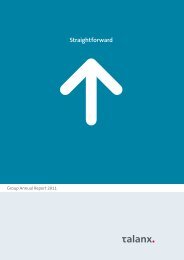Values
Values
Values
Create successful ePaper yourself
Turn your PDF publications into a flip-book with our unique Google optimized e-Paper software.
Company | Group Management Group Financial | Corporate Governance | Report of the | Boards/Mandates | Additional Information<br />
Report Statements Supervisory<br />
Board<br />
Income Statement<br />
Statement of Comprehensive Income<br />
Balance Sheet<br />
Cash Flow Statement<br />
Statement of Changes in Equity<br />
Notes<br />
Liabilities<br />
Trade payables and other originated fi nancial liabilities are carried<br />
at amortized cost, non-current liabilities are discounted.<br />
Liabilities in foreign currencies are translated at the exchange<br />
rate on the balance sheet date.<br />
Th e Bertelsmann Group has not yet exercised the option<br />
of classifying fi nancial liabilities initially recognized at fair<br />
value through profi t or loss.<br />
Derivative Financial Instruments<br />
As set out in IAS 39, all derivative fi nancial instruments are recognized<br />
at fair value on the balance sheet. Derivative fi nancial<br />
instruments are recognized as of the transaction date. When<br />
a contract involving a derivative is entered into, it is initially<br />
determined whether that contract is intended to serve as a fair<br />
value hedge or as a cash fl ow hedge. However, some derivatives<br />
do not meet the requirements included in IAS 39 for recognition<br />
as hedges despite this being their economic purpose. Changes<br />
in the fair values of derivatives are recorded as follows:<br />
1. Fair-value hedge: Changes in the fair value of these<br />
derivatives, which are used to hedge assets or liabilities, are<br />
recognized in profi t or loss, the corresponding gain or loss on<br />
the change in fair value of the underlying balance sheet item<br />
is also directly included in the income statement.<br />
2. Cash-fl ow hedge: Th e eff ective portion of the changes<br />
in the fair value of derivatives used to hedge future cash fl ows<br />
is recognized directly in equity under other comprehensive<br />
income. Th e amounts recognized in equity are then reversed<br />
to profi t or loss when the hedged item is recognized in profi t or<br />
loss. Th e ineff ective portion of the changes in the fair value of<br />
the hedging instrument is recognized in profi t or loss.<br />
3. Hedge of a net investment in a foreign operation: For<br />
this hedge type, the eff ective portion of the gains and losses<br />
on changes in the fair value of the hedging instrument is taken<br />
Bertelsmann Annual Report 2009<br />
Finance lease liabilities, which are also reported in fi nancial<br />
liabilities, are carried at their present value in accordance with<br />
IAS 17.<br />
directly to equity. Th e ineff ective portion is recognized in profi t<br />
or loss. On disposal of the investment, the changes in the fair<br />
value of the hedging instruments that are contained in equity<br />
are recognized in profi t or loss.<br />
4. Stand-alone derivatives (no hedge relationship): Changes<br />
in the fair value of derivatives that do not meet the criteria for<br />
recognition as hedges are recognized in profi t or loss in accordance<br />
with the held-for-trading category and are therefore classifi<br />
ed as at fair value through profi t and loss.<br />
If the trade date and the settlement date are diff erent, the<br />
settlement date is applied for the purposes of initial recognition<br />
of derivatives.<br />
Measurement at fair value:<br />
In the case of derivatives (held for trading and derivatives with<br />
a hedge relationship) measured at fair value, the valuation<br />
method applied depends on the respective valuation parameters<br />
present in each case. If listed prices can be identifi ed on<br />
active markets, these are used for valuation (phase 1). If this<br />
is not possible, the fair values of comparable market transactions<br />
are applied and fi nancial methods based on observable<br />
market data are used (phase 2). If the fair values are not based<br />
on observable market data, they are to be identifi ed with the<br />
aid of recognized fi nancial methods (phase 3).<br />
97
















